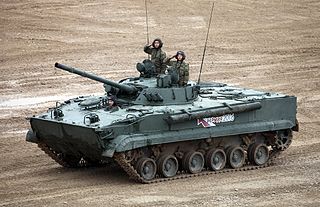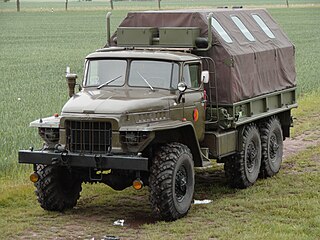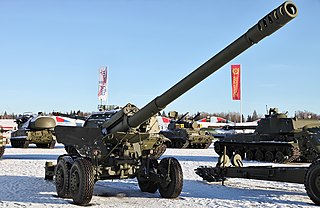
The Russian Airborne Forces is the airborne forces branch of the Russian Armed Forces. It was formed in 1992 from units of the Soviet Airborne Forces that came under Russian control following the dissolution of the Soviet Union.

The BMP-3 is a Soviet and Russian infantry fighting vehicle, successor to the BMP-1 and BMP-2. The abbreviation BMP stands for Boevaya Mashina Pekhoty.

An armoured recovery vehicle (ARV) is typically a powerful tank or armoured personnel carrier (APC) chassis modified for use during combat for military vehicle recovery (towing) or repair of battle-damaged, stuck, and/or inoperable armoured fighting vehicles, such as tanks and armoured personnel carriers. Most ARVs have motorized tracks, like a tank or bulldozer, enabling the ARV to operate on uneven ground. The term "armoured repair and recovery vehicle" (ARRV) is also used.

The BTR-80 is an 8×8 wheeled amphibious armoured personnel carrier (APC) designed in the Soviet Union. It was adopted in 1985 and replaced the previous vehicles, the BTR-60 and BTR-70, in the Soviet Army. It was first deployed during the Soviet–Afghan War.

The KSVK 12.7 or Degtyarev sniper rifle is a 12.7mm anti-materiel rifle developed in Russia for the purpose of counter sniping and penetrating thick walls, as well as light armored vehicles.

The Ural-375 is a general purpose 4.5 ton 6×6 truck produced at the Ural Automotive Plant in the Russian SFSR from 1961 to 1993. The Ural-375 replaced the ZIL-157 as the standard Soviet Army truck in 1979, and was replaced by the Ural-4320.

The M88 recovery vehicle is one of the largest armored recovery vehicles (ARV) in use by United States Armed Forces. There are three variants, the M88, the M88A1, and the M88A2 HERCULES. The M88 series has seen action in the Vietnam War, the Persian Gulf War, the Iraq War, and the War in Afghanistan, and to a lesser extent during the Kosovo War, where they were deployed to help recover heavy armored vehicles of the Allied ground units. As of 2000, the M88A2 replacement cost was around US$2,050,000.

TOS-1 Buratino is a Soviet 220 mm 30-barrel or 24-barrel multiple rocket launcher capable of using thermobaric warheads, mounted on a T-72 / T-90 tank chassis. TOS-1 was designed to attack enemy fortified positions and lightly armored vehicles and transports, particularly in open terrain. The system’s first combat tests took place in 1988 and 1989 in the Panjshir Valley during the Soviet–Afghan War. The TOS-1 was shown for the first time in public in 1999 in Omsk.

The UAZ Patriot is a mid-size body-on-frame SUV produced by the UAZ division of SeverstalAvto in Ulyanovsk, Russia. It was introduced in 2005 and replaced the older UAZ Simbir (UAZ-3162). Extensive use of newer parts, large carrying capacity, good off-road capabilities and an affordable price predicted good sales in Russia. 12,011 units were sold in the year 2007.

The 2A36 Giatsint-B is a Soviet towed 152 mm field gun which entered service in 1975. The 2A36 is designed to suppress and destroy enemy manpower and equipment. It is also suitable for counter-battery fire. The gun can be used in various weather conditions and has been tested in temperatures ranging from −50 °C to 50 °C.

The T-72 is a Soviet-designed main battle tank that entered production in 1973. It replaced the T-54/55 series as the workhorse of Soviet tank forces. In front-line Russian service, T-72s are being upgraded or augmented by the T-90, itself a modernized version of the T-72B. The T-72 has been exported and produced in many countries.

The Tornado is a family of related multiple rocket launchers developed by NPO Splav for the Russian Ground Forces. Variants of the system, which include the Tornado-G and Tornado-S models, have different capabilities and different battlefield roles. The Tornado is designed primarily to fire cluster munitions but also can be used to fire thermobaric warheads.

The Tigr is a Russian 4×4 multipurpose all-terrain infantry mobility vehicle manufactured by Military Industrial Company, first delivered to the Russian Army in 2006.

KamAZ Typhoon is a family of Russian multi-functional, modular, armored Mine-Resistant Ambush Protected vehicles manufactured by the Russian truck builder KAMAZ. The Typhoon family is part of Russia's Typhoon program. As of 2021, the number of Typhoons in the Russian Armed Forces fleet was about 330 units of Typhoon-K.

Typhoon is a Russian family of Mine-Resistant Ambush Protected (MRAP) armored fighting vehicles (AFVs) in service since 2014. Around 120 Russian companies including KamAZ, Gaz-Group, and Bauman University, etc. are taking part in Typhoon program. The main aim of the program is to design a unified platform for all Russian armored wheeled vehicles.

The 9K333 Verba is a Russian fourth-generation man-portable infrared homing surface-to-air missile (SAM) MANPADS. "9K333" is the Russian GRAU designation of the system. Its NATO reporting name is SA-29 Gizmo.

The TOS-2 (Tosochka) is a Russian multiple rocket launcher capable of using thermobaric warheads, mounted on a 3-axle truck chassis. TOS-2 was designed to attack enemy fortified positions and lightly armoured vehicles and transports, in open terrain in particular.

The TMM-6 is a Russian bridge-laying vehicle. It was developed by Omsktransmash in Omsk between 1999 and the late 2000s. It was built to replace older Russian bridge-launching vehicles.


















